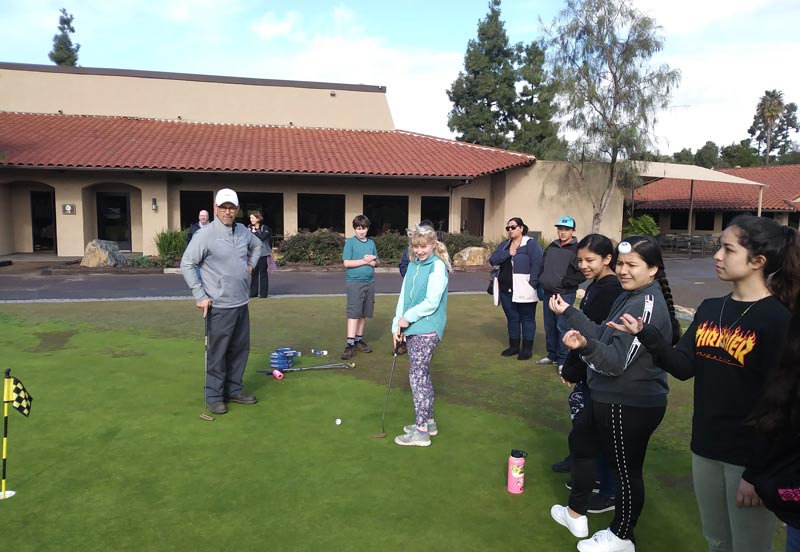
Bonita Golf Course superintendent Brendon Reaksecker (left) watches over the putting lesson portion of the First Green field trip at his facility on Monday, Feb. 4. Photo by Howard Richman
A worm turned on her golf ball and Mia Andrade was intrigued
A sixth-grader at Sunnyside Elementary School in Bonita, Calif., Andrade was among nearly 50 students who participated Monday morning in a First Green field trip at Bonita Golf Course. The excursion was presented in conjunction with the Golf industry Show seminar “Launching a First Green Field Trip Program at Your Own Golf Course.”
Students rotated through four stations throughout the field trip, one of which featured putting on the practice green. As Andrade clutched the putter and sent her golf ball toward a cup, a worm attached itself to the ball. “That was pretty weird and cool at the same time,” Andrade said.
The youths certainly appeared to have the time of their lives. The two-hour session was hosted by GCSAA Class A superintendent Brendon Reaksecker and marked the first time a First Green outing has been staged at GIS while under GCSAA’s umbrella of member programs.
Last summer, GCSAA assumed leadership of First Green, which was launched in 1997 in the Pacific Northwest. First Green’s charge: Golf courses become learning labs for students up to the 12th grade. The program focuses on STEM (science, technology, engineering and math) learning and emphasizes environmental education and stewardship and discovering the game of golf.
“We’re introducing kids to an environment they may not ever have seen,” says Reaksecker, a 20-year GCSAA member. “I sure enjoy seeing them excited, and it makes you realize what it’s like to be young again and see the brain firing.”
At Bonita Golf Course, students learned how to manage roots, that the value of Pi (the ratio of a circle’s circumference to its diameter) is 3.14, what native plants and habitat are, and just how important sand is out in the golfscape.
This living lab wasn’t just important to the students, though. Tom Pattison, an assistant superintendent at Blyth Golf Club in England who is attending GIS for the first time as part of Bernhard’s BIGGA delegation, planned to compile enough information to introduce the First Green blueprint back in his homeland.
“There’s nothing like this in the U.K. I think this would work there,” Pattison says. “It’s very important to at least try. If we could roll it out, patiently, it would be brilliant.”
Stella Rodriguez thinks it’s a hit. A math teacher at Sunnyside, Rodriguez says she was impressed by what the First Green event achieved. “It seems very hands-on. It’s small groups, and it’s outside. Kids don’t like to just sit and listen to a lecture,” she says. This wasn’t Rodriguez’s first time on a golf course, but the experience was still new: “I’ve been on a golf course for a wedding, and I didn’t pay attention to the grass,” she says.
As he turned to the golf course, student Julian Regladeo appeared awestruck by the size of it. He also seemed to suggest that becoming a golf course superintendent one day isn’t out of the question. “That is a lot of land you need to take care of,” Regladeo said. “You have to mow it and watch over it. It’d be fun — that’s what I think.”
Howard Richman is GCM’s associate editor.